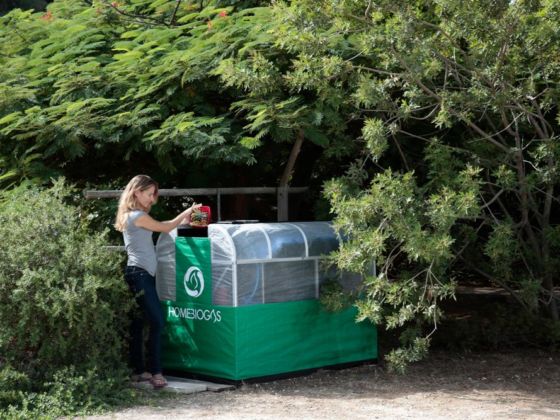OUR planet is in bad shape, but there’s no point reiterating the same ominous numbers and catastrophic scenarios — we all know what they are and what the future holds for us if nothing is done quickly. This is why, this Earth Day, Matador Network would like to focus on a more positive outlook and showcase the creations people are coming up with to help our world be more sustainable. Below are 10 amazing inventions that can dramatically reduce our plastic pollution, our green gas emissions, our fossil fuel consumption, and our water usage to help our planet recover from all the hardship we put her through.


In Honor of Earth Day, Here Are 10 Innovations That Can Save Our Planet
1. The edible water bubble
Ooho! is a bubble made of seaweed extract containing 250 milliliters of water. It is entirely biodegradable and natural so you can eat/drink it whole (if not, the membrane decomposes in 4 to 6 weeks). It is a brilliant alternative to plastic water bottles, not only because it reduces the amount of plastic produced and trashed but also because it is much cheaper (it costs only around two cents to produce according to Onegreenplanet). The good people at Skipping Rocks Lab, the brains behind Ooho!, are well on their way to crush plastic pollution. For more about Ooho!, follow the project on Facebook.
2. The Seabin
Pete Ceglinski and Andrew Turto invented the Seabin, an amazing floating trash can. Although the world’s oceans need a thorough clean-up, Ceglinski and Turton decided to start by taking care of the waters of marinas, private pontoons, inland waterways, residential lakes, harbours, waterways, ports and yacht clubs. Not only are these areas often heavily polluted, but they are also protected from ocean swells and storms, which makes it easier to collect floating rubbish, oil, fuel and detergents.
The Seabin is automated and works 24 hours a day, 7 days a week, and the process is quite simple. The trash can stays on the water’s surface but is connected to a dock via a water pump. Water gets sucked into the Seabin, carrying floating debris and floating liquids inside. The waste gets caught inside a net in the trash can and the water flows out into the pump on the dock. An oil/water separator can be installed in the pump to clean the water before it is sent back into the oceans. To know more about the Seabin, visit the project’s Facebook page.
3. Beeswax food wraps
Bee’s Wrap is made of organic cotton, beeswax, organic jojoba oil, and tree resin. It is a sustainable alternative to the nasty single-use plastic cling wrap and a healthier option to store your food. It can last up to a year if used several times a week. Vermonter Sarah Kaeck is another entrepreneur who is kicking plastic pollution in the butt. For more about Bee’s Wrap, check out this website.
You can also attempt to make your own beeswax food wrap following the instructions in the video below:
4. Waterotor
Waterotor is a water turbine that uses the slow current of any body of water to produce high energy. According to Waterotor’s website, “Water has 830 times more energy than wind thus a small device in water can economically harness a large amount of energy around the clock”. It’s an alternative to polluting fossil fuel generators that are currently supplying power in most of the world. To know more about waterotor, visit this website.
5. WaterSeer
WaterSeer is a brilliant invention that allows anyone to have access to clean, safe drinking water without electricity, labour, or damage to the environment. The device extracts water from the atmosphere by a condensation process and can collect up to 37 liters of water a day. For more about waterseer, visit this website. If you are interested in helping to finance WaterSeer, visit the Indiegogo campain here.
6. Transparent solar panels
A team led by Richard Lunt, an assistant professor of chemical engineering and materials science at Michigan State University invented a transparent solar panel that could replace windows and produce enough electricity for entire buildings. The technology also works for any sheet of glass, so your cell phone screen could be covered in one of these panels and be powered by the Sun. For more details about this project check out this article by Extreme Tech.
7. Banana leaf leather
Here is an ethical and ecological alternative to leather that is not only durable but also water resistant. Using the green waste from the 200,000 banana trees growing on the island of Kosrae in Micronesia, a small team created a fibre that resembles leather. To support this community-oriented, sustainable project, check out the kickstarter campaign here.
8. Homebiogas
Homebiogas turns your food waste into cooking gas. You simply set up biogas in your backyard where you would have a composter and hook it to your stove’s gas supply. You get to create you own clean energy and reduce the waste that would otherwise end up in the landfills. Check out Homebiogas’ website here for more details.
9. Mycofoam
Mycelium technology is on its way to take over styrofoam and we could not be happy enough — styrofoam is a petroleum product that is incredibly polluting and very dangerous for wildlife. Mycofoal is a mushroom packaging that is renewable, biobased, and compostable. Mycofoam protect products just as well as styrofoam and is cost competitive. This packaging product is already used by Dell, and Ikea is on its way to adopting it. Learn more at www.ecovativedesign.com.
10. Nebia shower
Nebia showers use 70% less water than a regular shower, so you not only save money, but you also reduce your water footprint dramatically. For more information about Nebia showers, visit their website here.
If you know of more amazing creations that could benefit the environment, let us know in the comment section.